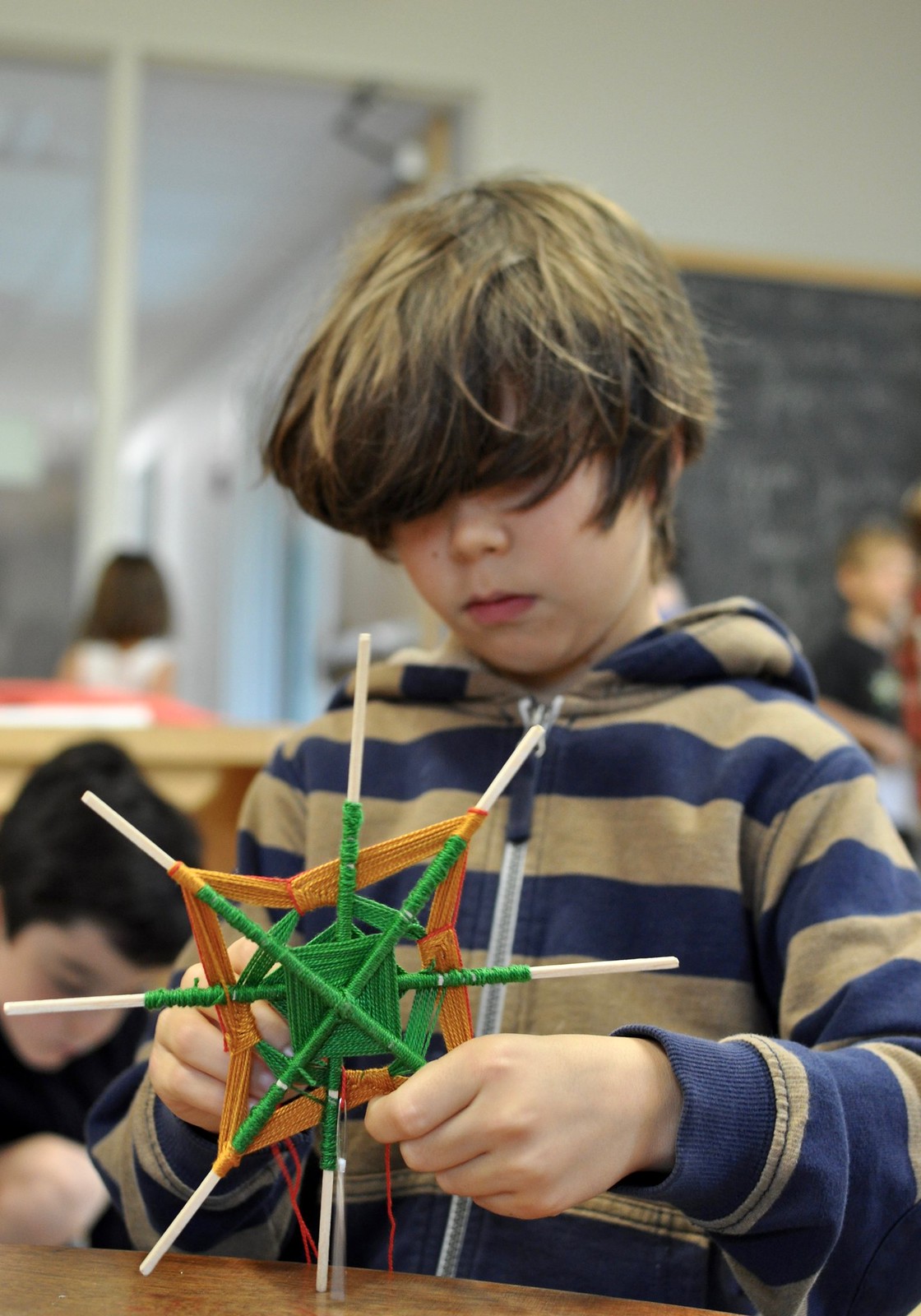The Benefits of Handwork for Children
 During the course of your child's week, he will most likely engage in some form of repetitive, relaxing, even hypnotic work that results in a seemingly mile-long loop of finger-knit yarn, or perhaps a painstakingly detailed Gods-eye weaving, or even a useful potholder that he has woven on a loom! What's behind all of these creations, and why do we love handwork so much here at Villa di Maria? The answers, below.
During the course of your child's week, he will most likely engage in some form of repetitive, relaxing, even hypnotic work that results in a seemingly mile-long loop of finger-knit yarn, or perhaps a painstakingly detailed Gods-eye weaving, or even a useful potholder that he has woven on a loom! What's behind all of these creations, and why do we love handwork so much here at Villa di Maria? The answers, below.  Handwork is, quite literally, work that is done with the hands. Though it can include a wide array of Montessori lessons, from hand-washing to metal insets, to manipulating nuts and bots, to the buckle frame... (nearly everything in the Children's House could be included on this list), for the purpose of this post, we will be referring to handwork specifically as the kind of work that results in a finished product.
Handwork is, quite literally, work that is done with the hands. Though it can include a wide array of Montessori lessons, from hand-washing to metal insets, to manipulating nuts and bots, to the buckle frame... (nearly everything in the Children's House could be included on this list), for the purpose of this post, we will be referring to handwork specifically as the kind of work that results in a finished product. In the Lower Elementary, children are often seen engaging in handwork during read-aloud, free time, or even during recess. Some general examples are weaving, crocheting, origami, beadwork, embroidery, jewelry-making, knitting, needlepoint, calligraphy, carpentry, and carving, though there are many other activities that can be considered handwork.
In the Lower Elementary, children are often seen engaging in handwork during read-aloud, free time, or even during recess. Some general examples are weaving, crocheting, origami, beadwork, embroidery, jewelry-making, knitting, needlepoint, calligraphy, carpentry, and carving, though there are many other activities that can be considered handwork. Anna Schwind, Lower Elementary Guide, shared what is so great about handwork, and why we see so much value in it. Handwork serves to:
Anna Schwind, Lower Elementary Guide, shared what is so great about handwork, and why we see so much value in it. Handwork serves to:
- develop and refine the motor skills of the child, particularly those of the fingers and hands
- create for the child a connection between a sensorial experience and the act of creation
- demonstrate through experience that practice improves a skill, and the world is full of skills the child may attain and perfect for themselves
- give the child multiple avenues to create something they find meaningful and even beautiful
 There is so much going on with handwork, including coordination, concentration, and self-correction. But perhaps what sets aside handwork from other Montessori works is its ability to provide creative outlet to a child. There is the opportunity for self-expression here that is unparalleled. A child can also exert his will through handwork: he may choose the colors, the pattern, the size and scale, and can be proud of the unique results.Making something beautiful with your hands is satisfying in itself, but there are also therapeutic benefits of working with your hands. Being active with your hands can often quiet the mind, leading to a natural way to de-stress or even process emotions. Handwork can be an intensely effective relaxation tool; the mind cannot help but slow down as it matches the rhythm of the hands.
There is so much going on with handwork, including coordination, concentration, and self-correction. But perhaps what sets aside handwork from other Montessori works is its ability to provide creative outlet to a child. There is the opportunity for self-expression here that is unparalleled. A child can also exert his will through handwork: he may choose the colors, the pattern, the size and scale, and can be proud of the unique results.Making something beautiful with your hands is satisfying in itself, but there are also therapeutic benefits of working with your hands. Being active with your hands can often quiet the mind, leading to a natural way to de-stress or even process emotions. Handwork can be an intensely effective relaxation tool; the mind cannot help but slow down as it matches the rhythm of the hands. Another benefit of handwork? It can encourage connection. A child who learns to make things with his hands may also discover that he wants to give these creations to those he cares about. We have witnessed one child who learned to make hats on a simple loom then decide that he would make a hat for every child in his neighborhood. Upon delivering them, he made the sweetest connections with his community, which continue to this day.And perhaps the best thing about handwork? It can be done at home!
Another benefit of handwork? It can encourage connection. A child who learns to make things with his hands may also discover that he wants to give these creations to those he cares about. We have witnessed one child who learned to make hats on a simple loom then decide that he would make a hat for every child in his neighborhood. Upon delivering them, he made the sweetest connections with his community, which continue to this day.And perhaps the best thing about handwork? It can be done at home!

